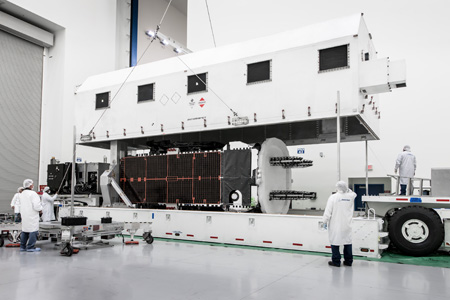Boeing Ships 3rd Intelsat 702MP Satellite for Launch

Intelsat 27 arrives at Sea Launch home port
Deliveries of Medium Power satellites continue on or ahead of schedule
The third of four 702 Medium Power (MP) satellites that Boeing is manufacturing for Intelsat S.A., the world’s leading provider of satellite services, arrived at the Long Beach, Calif., home port of launch provider Sea Launch on Nov. 28. Scheduled for launch in the first quarter of 2013, Intelsat 27 is designed to provide media, network and government communications services that will span North America, South America and Europe.
“By working together with Intelsat and building on the 702MP’s flexible, modular design, we have tailored each satellite to offer the specific capabilities required while delivering them on or ahead of schedule,” said Craig Cooning, chief executive officer of Boeing Satellite Systems International and vice president and general manager of Boeing Space & Intelligence Systems.
Boeing introduced the 702MP line of satellites in 2009 in response to customers’ need for spacecraft with 6 to 12 kilowatts of power. The approximately 12,000-pound (5,450-kilogram) Intelsat 27 spacecraft is designed to provide 15 or more years of service. As part of Intelsat’s fleet replacement and expansion plans, Intelsat 27 will be located at 304.5 degrees east longitude and will replace Intelsat 805 and Galaxy 11. The satellite will complete Intelsat’s global broadband mobility platform, which will consist of 10 beams on seven satellites. Intelsat 27 is also augmented with a UHF hosted payload for use in government applications. In addition, the satellite will provide direct-to-home and video distribution services.
After undergoing preflight checkout at Sea Launch home port, Intelsat 27 will be transported by ship to a location in the South Pacific Ocean for liftoff aboard a Zenit-2S rocket, becoming the second 702MP to be launched by Sea Launch. It will enter service in geosynchronous orbit above Latin America.
